Causes
Stamp Act March 22 1765
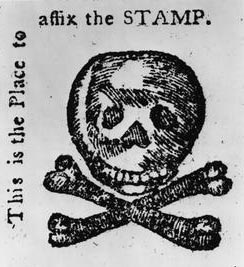
It was a fee for services in the form of a stamp that had to be purchased and then stuck on items that were bought and sold. Stamps also had to be bought for documents. The Stamp Act affected everyone and Americans were enraged. The Colonists had no representatives in the British Parliament and felt they were being taxed without consent. Officials sent out to enforce the Stamp Act were often attacked, some were Tarred and Feathered. The Stamp Act was repealed in 1766
Townshend Acts June 1767
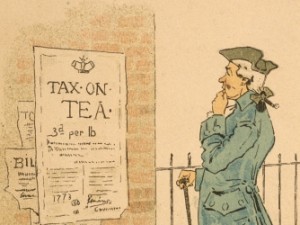
Parliament imposed the Townshend Acts, which included new duties on paper, paint, glass, and tea- all goods that had to be shipped in from the outside colonies. It actually raised little money and was really meant for Britain to prove to the colonies that they still had the right and authority to tax them. The Colonies once again, protested and then the Act was abolished, except the tax on tea.
Boston Massacre March 5 1770
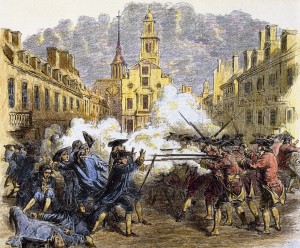
In 1770 nervous British soldiers misunderstood an order and fired their muskets into a mob of protesters in Boston, killing several people. The “Boston Massacre” was quickly turned into anti-British propaganda by colonial leaders
Tea Act May 10 1773 and Boston Tea Party December 16 1773
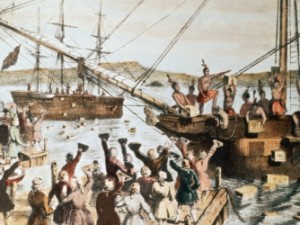
In 1773, about 116 people boarded English ships docked in Boston. They then destroyed a fortune in tea by throwing it into the harbor. The event was meant to protest the Tea Act that still protected the British East India Company, who had a monopoly on the colonists. It was one of the most important symbolic events leading to the American Revolution
Intolerable Acts/Coercive Acts April 22 1774

Boston Port Act Closes the Port of Boston until the East India Company is compensated for the destroyed tea.
Massachusetts Government Act All positions in the colony’s government are now appointed by the British. Town meetings can be held only once a year.
Quartering Act Colonial governors may house soldiers in any unoccupied building. Colonists believe this includes private homes.
Administration of Justice Act British officials accused of crimes can have their trials held in another colony- or even Great Britain.
Quebec Act Made the French language and Roman Catholicism official in the British colony of Quebec. The city’s boundaries were spread far into Ohio Valley. It was another Intolerable Act to the Colonies.
First Continental Congress September 5 – October 26 1774
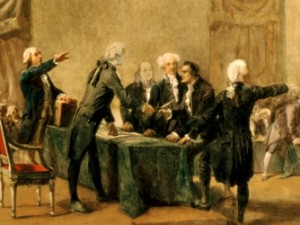
In 1774, all of the Thirteen Colonies except Georgia sent delegates to the First Continental Congress in Philadelphia. They began defying the British and cutting economic ties to the home country. As British General Gage readied thousands of British troops from his headquarters in Boston, rebellious colonists began to train and store weapons and ammunition.
Components
Battle of Lexington and Concord April 19 1775
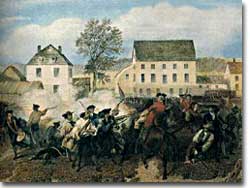
King George declared Colonies in state of rebellion and sent General Tomas Gage to disarm colonists and arrest leaders. Gage then sent 700 troops under Francis Smith to seize/destroy weapons in Concord, but the Colonists knew weapons in danger and hid them. Dr. Joseph Warren alerted members of Sons of Liberty, One of them went out to gather militia, other warned Concord. Then the British arrived and the “Shot Heard Round the World” happened, but only god knows who fired it. Redcoats marched to concord and had 8 minutemen killed 10 wounded but the numbers of minutemen swelling. Redcoats destroyed several cannons and leftover ammo but the Minutemen held bridge, Redcoats retreat then they exit Concord to Boston but Colonists shoot Redcoats from hidden positions along the way. Redcoats angered by their hidden enemy and the brutal scalping of one of their own, pillage houses and villages nearby, killing many colonists. When they finally made it to Boston, 73 Redcoats were killed and 174 were wounded.
Battle of Bunker Hill June 17 1775
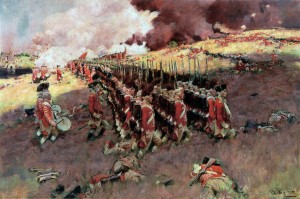
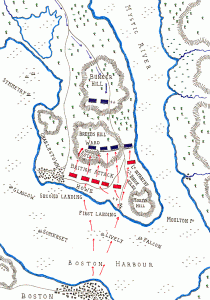
American troops were sent to entrench on Bunker Hill, overlooking Boston from where they could bombard the British troops and ships but they made a mistake and went to Breed’s Hill instead, which is closer to the British position. When the British found the Americans they could have used their ships and surrounded them, but instead charged them uphill because they thought the Americans would retreat from the head-on attack. They were most definitely wrong as It took two attempts of attacking and retreating until the third where they finally took the hill. Even though they won they had MAJOR CASUALTIES, out of the 2300 troops, 1054 were either killed or injured.
Thomas Paine’s Common Sense February 14 1776
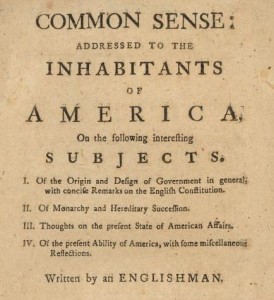
The Majority of Colonists were told from birth to love England and the monarch and fear was another factor against breaking ties. with the Americans divided, Thomas Paine provided the extra push for independence. He published Common Sense in January with two main points: Independence from England and the creation of a democratic republic. Also Paine was not religious but he knew his readers were and Common Sense grew the patriot cause.
Declaration of Independence July 4 1776
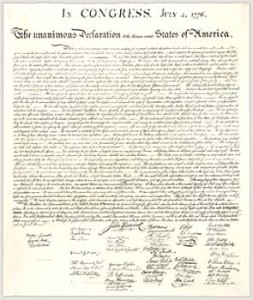
The formal document of why the colonies are breaking away from Great Britain. Five people we chosen to create it, among them was Tomas Jefferson, Benjamin Franklin, and John Adams. Though this was an act of treason to do so.
Battle of Trenton December 26 1776

Patriot morale was low and to highten morale George Washington planned the attack on the Hessians from three different directions. Problem was, crossing the Delware river was difficult because of the weather. The Hessians were overun and after the battle there was only two American casualties which were both from the weather, but they captured 896 Hessians.
Battle of Saratoga October 7 1777
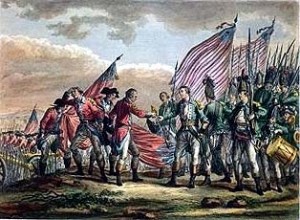
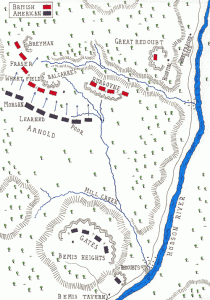
The British planned to cut off New England from the rest of the colonies by taking New York, Albany and the Hudson River. Generals Burgoyne, St. Leger and Howe would meet at Albany to defeat the rebel armies but, Burgoyne’s army became trapped in Saratoga blocked by General Gates October 7, 1777. Burgoyne attempted to attack the larger Patriot force and Burgoyne’s army was defeated by Arnold’s army at Bemis Heights due to a lack of supplies and high casualties, Burgoyne surrendered. The Patriot victory at Saratoga was a turning point in the war. It renewed the morale of the Americans as well as convinced France the Americans could win the war and decided to support the Americans, France sent generals, troops, ships, supplies, money to help Americans win the war.
Battle of Camden August 16 1780

In 1780 the British shifted their focus to the Southern Colonies and took loyalist stronghold of Savannah and Charleston as well as 5000 Patriot soldiers. The Continental Congress gave Horatio Gates command of second southern army. Gates had this army near Charlotte, north Carolina and ordered the group of Continental Soldiers and militia to march to British lines in south Carolina. Of the 4k soldiers half were ravaged by disease or exhaustion and others had little or no military experience. Redcoats found out and sent more then 2k troops to Gates. The Redcoats inflicted heavy casualties in Patriot Right flank via volleys then charged with their bayonets. The Patriots fled, then Gates army (as well as himself) fled. With over a thousand captured and 900 killed or wounded and the artillery and baggage train were captured as well as the patriot operation in the south utterly crippled, Gates was replaced by Nathanael Greene.
Battle of the Cowpens January 17 1781
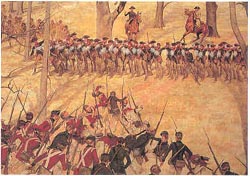
 After the initial British charge the first two lines of Patriot fighters withdrew. Tarelton believed the Patriots were in full retreat and ordered soldiers to charge but, Tarelton was not aware of a third line of Patriot fighters waiting for the British charge and British forces charged directly into the third line of Patriots who halted British advance with a bayonet charge. British soldiers surrendered and others turn and ran. The British army was outflanked and Patriot forces began attacking the British from behind. British forces began to retreat despite Tarelton urging them to continue fighting. Morgan captured 712 British soldiers and 110 British soldiers were killed. The battle was a turning point for the Southern campaign as the Battle of the Cowpens ultimately was the first step in the eventual end of the war as it caused Cornwallis to abandon South Carolina, engage Greene at Guilford Courthouse and eventually withdraw his army to Yorktown where his army would eventually come under siege and surrender.
After the initial British charge the first two lines of Patriot fighters withdrew. Tarelton believed the Patriots were in full retreat and ordered soldiers to charge but, Tarelton was not aware of a third line of Patriot fighters waiting for the British charge and British forces charged directly into the third line of Patriots who halted British advance with a bayonet charge. British soldiers surrendered and others turn and ran. The British army was outflanked and Patriot forces began attacking the British from behind. British forces began to retreat despite Tarelton urging them to continue fighting. Morgan captured 712 British soldiers and 110 British soldiers were killed. The battle was a turning point for the Southern campaign as the Battle of the Cowpens ultimately was the first step in the eventual end of the war as it caused Cornwallis to abandon South Carolina, engage Greene at Guilford Courthouse and eventually withdraw his army to Yorktown where his army would eventually come under siege and surrender.
Battle of Guildford Courthouse March 15 1781

The British only had 1,900 vs the American 4,500 troops. The British won with the loss of 500+ Soldiers, though this would be the last “major” victory for the British.
Battle of Yorktown October 6-19 1781

Six years into the war and Washington’s army is tired and broke. It is the Summer of 1781. Needed a victory that could change the tide, maybe even end the war. Washington gets help from the French. Land forces trapped Cornwallis’ army west and Comte de Grasse’s fleet trapped him from the east and there would be no British reinforcements. On October 6, 1781, Washington’s troops dug a trench 2k yards long and 3 days later cannons and guns were dragged into place, by the afternoon bullets were sprayed into the British defense from land and sea, this persisted through the night and many Redcoats began deserting. As things went on, trenches were dug closer and closer, As only a matter of time Cornwallis surrendered though previously tried to escape. This was the last major battle.
Consequences
Treaty of Paris 1783
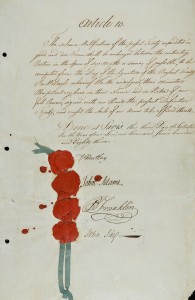
Britain agreed to recognize American independence. They gave Americans fishing rights to the Grand Banks off the coast of Newfoundland. Britain also granted the U.S. all territory between Allegheny Mountains on the east and Mississippi River on the west.
Loyalist
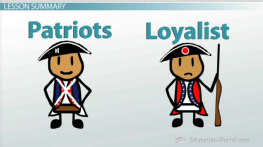
Approximately 20% American colonists supported British rule and remained loyal. They were persecuted by the Patriots during the war Patriots abused them and burned their homes and farms. After the revolution and Treaty of Paris was signed, between 80,000-100,000 Loyalists had to leave U.S.. Many settled in other British colonies in North America – Quebec, Nova Scotia and Island of St. John (PEI)
Constitution 1789

It outlines the structure and powers of government. The three branches of government are separate, checked and balanced off by the power of the other two. The U S Constitution is supreme. All persons are equal before the law and people can change the constitution.
Bill of Rights 1791
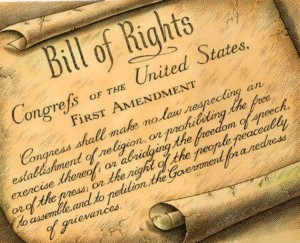
The first 10 amendments (additions) of the constitution represent ideals regarding individual liberty, limited government, and the rule of law
Worldwide Influence
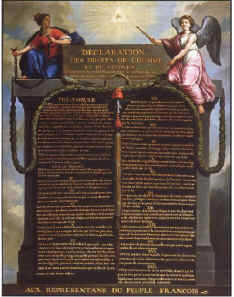
American Revolution spread ideas of liberty, individual rights and equality to other parts of the world. It influenced and inspired other revolutions around the world such as France in 1789. American Declaration of Independence had some impact on the French Declaration of the Rights of Man and the Citizen of 1789